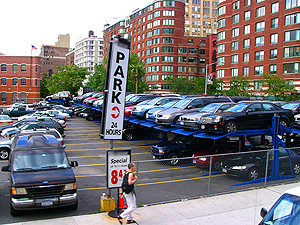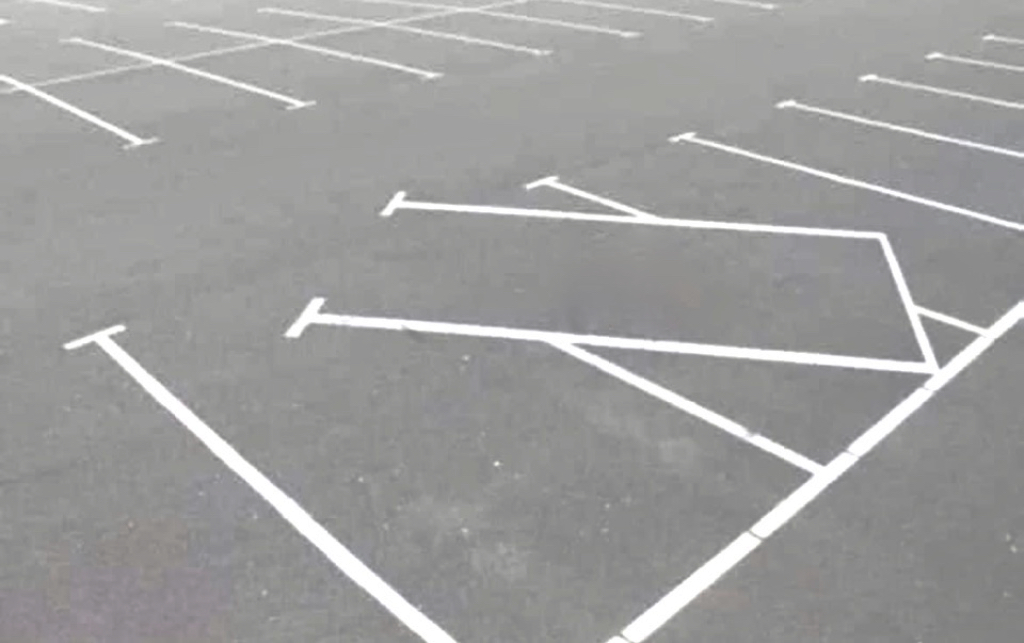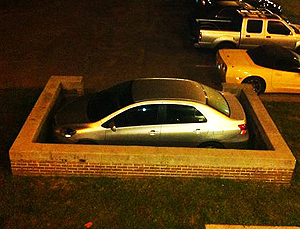
Completely safe parking spots like this aren’t always easy to find, but practicing a few simple parking rules will keep your car equally ding- and dent-free. (Photo credit: L. Jones)
(by contributor Kristi Burns)
When I began dating my husband many years ago, he let me use his car, providing that I follow a few “rules” to keep it free from dings, scratches, and dents.
Since I was able to pass those tests and we’re still together today, I thought I’d pass on what I’ve learned to help you keep your car looking its best and free from dents, dings and scratches – at least when parking.
“Connor, on parking”:
1. ALWAYS FIND THE MOST REMOTE SPOT AWAY FROM OTHERS.
Very basic logic, but it’s more difficult to put into practice than you might think. Whether parking on the street or in a lot, it’s something you have to practice 100 percent of the time for it to be effective – no matter how inconvenient it may be. It only takes one time plunking your car down in a high-risk spot for a door ding to occur. Dents and scratches don’t care that you were late for work, it’s raining out, or that you didn’t want your guests to walk further. Usually when I’m driving and friends are along, I’ll drop them off at the door to spare them having to walk all the way back from parking in the “boonies”. It spares me from listening to any complaining, too.
Of course, after I’ve parked out in the remotest reaches of a parking lot with no one around me, it’s very frustrating to return and find another car is parked right next to mine even though we are completely surrounded by empty spots.

Parking the right way can be a lonely pursuit. (This is not an active video.) (Photo Credit: Arnold Worldwide)
A favorite car commercial features a 2000 Volkswagen Passat driving around looking for a parking space at a Target or other big box store.
My husband and I had a 1999 Passat identical to it for ten years (even the same color), and we felt whoever made the commercial could have been taking an aerial video of us. More about specific spots later.
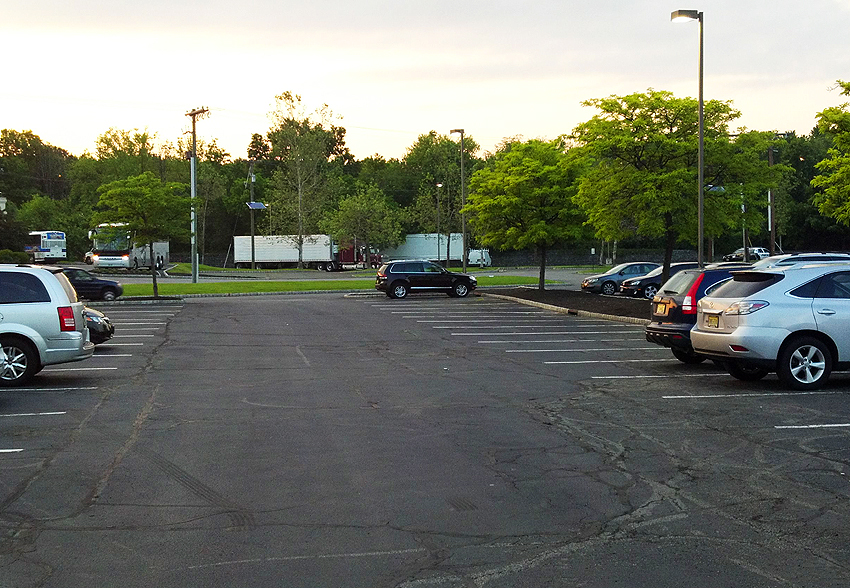
Another remote spot. No cars next to me, and none next to me when I returned. (Photo credit: K. Burns)
2. AVOID LETTING VALETS OR GARAGE ATTENDANTS PARK YOUR CAR.
I can’t tell you the number of times we’ve arrived late somewhere because my husband or I have looked for a spot on the street instead of using a parking garage, or drove around a parking lot searching for a better spot ourselves instead of giving the keys to a valet. However, those times have paid off (except when we got a ticket).
Valets.
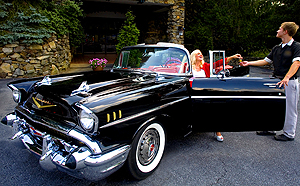
Avoid valet parking whenever possible, especially if you own a 1957 Chevrolet Bel Air convertible. (Photo credit: F. Dory)
Although they mean well, valets are in a hurry to park your car or retrieve it. They’re not paying attention to how close they park to one another, or how careful they need to be in order to avoid door contact when jumping in and out of cars.
In college, my husband worked for a valet service and remembers many such horror stories as well as valets almost colliding with each other in the parking lot trying to hustle. Give a tip out of courtesy if you need to, but park the car in their lot yourself.
Parking garages.
Usually, paid parking garages and lots exist because you’re in a crowded metro area and space is at a premium. Avoid them. Attendants park cars inches from one another in order to maximize the number of cars that can be squeezed in. That’s when disaster can strike easily.
Parking garages that put your car on a lift should be avoided at all costs. There’s no telling if a car that’s going to end up on a lift directly over yours for hours has an oil or other fluid leak. Plus, your car will likely be moved around multiple times in very tight spots during the course of its stay to let other ones in and out. I drive to New York City regularly and rarely use a garage unless absolutely necessary. In Manhattan, finding a spot on the street is a quest in itself and sometimes one just has to bite the bullet and deal with it.
3. ALWAYS LOOK FOR THE BEST TYPES OF PARKING SPACES.
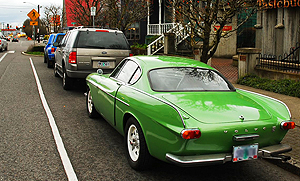
Parallel parking on the street can often be safer than parking in a lot. 1969 Volvo 1800S shown. (Photo credit: A. Galles)
Park on the Street Rather Than in a Parking Lot. This one may seem to go against common sense, but hear me out and practice your parallel parking skills. While neither is a perfect solution, parking on the street means you only have a person in front and/or behind you instead of next to you. While bumper mishaps are always possible, the likelihood of them happening is far less than door impacts.
End spots. It’s just common sense to eliminate half the risk of getting dinged by slotting your car where only one other person can park adjacent to you. If in a parking lot, find an edge spot. If on the street, look for a parallel spot by a corner, fire hydrant, or a driveway entrance. Since no one will park there, you can now give a wider berth to the one spot in front or behind you that will see traffic.
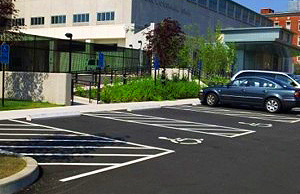 Spots right next to handicapped ones. Usually they’re the closest to the door and get taken the fastest, but great to find when possible. The neighboring handicapped spot usually has so much extra room on both sides, you can edge closer to the handicapped side. This puts you a foot farther away from the “normal” high-risk spot on your other side. Most likely, the handicapped spot will remain empty the entire length of your visit.
Spots right next to handicapped ones. Usually they’re the closest to the door and get taken the fastest, but great to find when possible. The neighboring handicapped spot usually has so much extra room on both sides, you can edge closer to the handicapped side. This puts you a foot farther away from the “normal” high-risk spot on your other side. Most likely, the handicapped spot will remain empty the entire length of your visit.
Scan the parking lot for curved corners. These often have wider spots around the curved parts. At our favorite movie theater, there are two such spots that are extra wide and ideal for parking our SUVs and other nice cars when we go there.
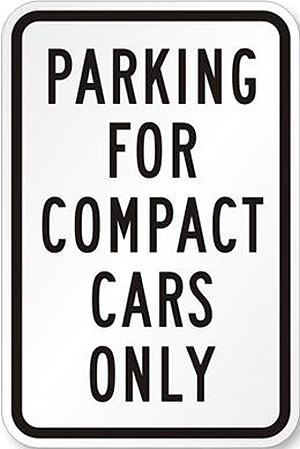 Pay attention to signs. Parking-spot width can vary greatly. More and more garages and have signs saying “compact cars only”. The trick is to notice these signs and avoid them.
Pay attention to signs. Parking-spot width can vary greatly. More and more garages and have signs saying “compact cars only”. The trick is to notice these signs and avoid them.
Needless to say, these spots are really small and parking in them (even if it’s closer to your floor or destination) can lead to easy regret. My office has compact car spots that are very tight, and the compact car drivers are very testy about larger cars using those spots for good reason.
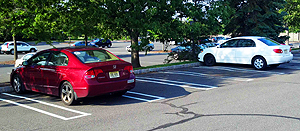
Parking spots designated for compact cars are increasing in number. They usually feature double lines between each space, as shown here. (Photo credit: K. Burns)
When you see double-lined spots, those are usually for compact cars; single-lined spots are for larger cars and SUVs. This leaves room for opening the wider doors without leaving dents.
Posts and columns are your friends. If you don’t hit them yourself. When possible, park so there’s a post or column on one side or the other of your car. You may want to let those on the passenger side of the car out first before squeezing as close to the column as possible to maximize cushion space on your other side. Parking between two columns is ideal protection, if such a spot can be found.
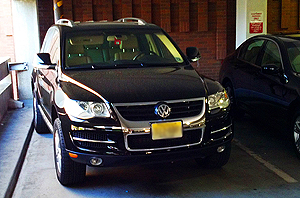
Two birds, one parking job – At an angle in the spot, as well as backing in against the wall. (Photo credit: K. Burns)
You may also wish to back in to protect it the same way. This also applies to parking next to a wall or other stationary object that would prevent another car from parking next to you.
Park at an angle. Because only the corners of your car will hug the edges of your parking spot, this minimizes the ability of a careless person to park close enough along the side of your car to cause damage.
Park cautiously, yet considerately. When I see someone who has a nice car – or only nice in their own mind – taking up TWO spaces, that’s definitely not cool. We get it: you love your car. Recently, we were pulling into a church parking lot attending a funeral and looking for a spot. Every one was taken, save for a Ford Explorer deliberately parked across two of the closest spots near the church. Because we were running late, we had no choice but to create our own spot halfway up on the grass. Not ideal at all. If I knew who had double-parked, I would have asked them to move – politely.
4. SOME CARS ARE WAY BETTER THAN OTHERS TO PARK NEXT TO.
When it can’t be avoided, use good judgement is selecting a parking spot neighbor. Naturally, you want to park next to a car that someone obviously cares for, rather than one whose vehicle already has dents, scratches, falling off mirrors, bumpers, hasn’t been washed in ages, etc. You may also want to stay away from large vehicles that block your view when you’re pulling out if you’re in a smaller vehicle, such as a Mini, Fiat, or Beetle. But ideally…
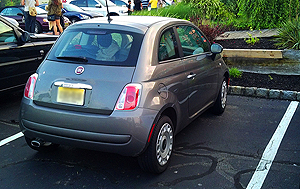
This 2011 Fiat 500 is one of the best types of cars to park next to – small, and in nice condition. (Photo credit: K. Burns)
Look for the smallest cars. With today’s higher gas prices, they’re becoming more common. They leave valuable extra space on both sides of them, and they have small doors which don’t extend outwards as far towards yours – even on two-door versions. Of course, new ones are ideal because small economy cars tend to rate low on the automotive passion meter. As a result, they get used up and thrown away more.
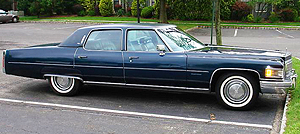
Classic cars in nice condition, like this restored 1976 Cadillac Fleetwood, are usually owned by people that appreciate cars. And who will respect yours. (Photo credit: G. Hartford)
Look for nicely restored classic cars. Unless gargantuan exterior dimensions cause them to bulge out of the spot they’re parked in, classics are valuable parking lot neighbors when they can be found. Especially if equipped with “Historic” license plates. Owners took great care and expense to restore them or purchase them as such. So they appreciate automobiles and will take extra care not to damage yours.
 Look for expensive sports cars of any vintage. Owners will most likely be fanatical about keeping them nice and free of dents, so they won’t carelessly slam a door into your car…because that will leave a mark on theirs. You will probably find these cars in the same ideal spots you’re trying to get though.
Look for expensive sports cars of any vintage. Owners will most likely be fanatical about keeping them nice and free of dents, so they won’t carelessly slam a door into your car…because that will leave a mark on theirs. You will probably find these cars in the same ideal spots you’re trying to get though.
I’m surprised to see this one not parking as close to the curb/corner spot on the passenger side as possible.
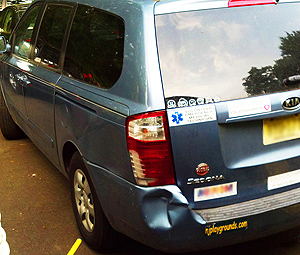
While ALL minivans should be avoided, this goes double for scratched and dented ones. Owners rarely care about them, and will care even less about being careful around your car. Minivans always mean multiple children – quite possibly reckless ones. (Photo credit: K. Burns)
Avoid all minivans. You should also look out for Minivans, even if they appear in the best condition. While they don’t have traditionally opening rear doors (sliding doors instead), they’re most likely to be filled with kids holding toys in their hands that will not have the knowledge to be careful in what they do.
Also, it’s wise to park away from where children will be playing as a general rule. They may not mean to damage your car, but it could easily happen. The same could be said for adults playing games too.
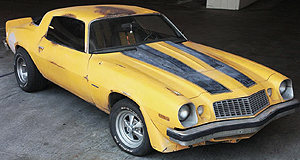
If there’s a choice, avoid bigger two-door cars. Their long doors need to swing open wide to allow ingress or egress. Parking next to ones in poor condition like this 1977 Camaro are sure ways to get door dings.
5. ENVIRONMENTAL HAZARDS CAN CAUSE DAMAGE TO YOUR CAR TOO.
In our townhouse complex, each person has a garage and one space immediately outside it underneath a raised patio deck for parking. This poses challenges for my husband and me because we have a classic car in the garage and a daily driver under the raised patio. The other daily driver is parked in the “gen pop” section.
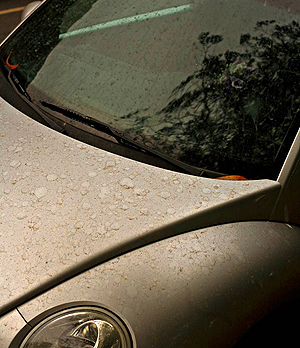
Be careful what trees you park under. Evergreen and maple tree sap harden quickly on automotive paint and glass to form a damaging layer. (Photo credit: S. Freeman)
The best spots in the section devoted to resident parking are usually taken by the time I get home from after-work activities. Those remaining are under pine trees that drip large amounts of sap. I try to avoid the tree sap by parking in “visitor” spots but get harassed by the condo board for doing so.
Sap, rain, sun and any kind of environmental hazard such as hail or high winds will damage your car as well. During Hurricane Irene last summer, my husband moved one vehicle to the parking garage downtown so it wouldn’t get hit with any hail or branches being thrown around by Irene. Thankfully, the car under the patio was OK.
Every other year our condo association refinishes and re-stains our patios, which are wood and, as I mentioned, are raised over our garages. When this event occurs, my husband parks both cars in resident and even visitor parking so the stain doesn’t drip down on the cars’ paint finish during periods of rain. Only a few others are as conscientious about their cars as I am about ours.
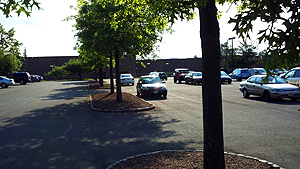 Office parking lots can be very out in the open. If you can find the motivation to get to work early for a good end spot, do so by all means. If that involves parking under trees, avoid ones that emit sap. Seeds, buds, and pollen they may drop don’t cause any permanent damage, although it’s good to clear them off the car so they don’t find their way into water drainage areas and cause clogs.
Office parking lots can be very out in the open. If you can find the motivation to get to work early for a good end spot, do so by all means. If that involves parking under trees, avoid ones that emit sap. Seeds, buds, and pollen they may drop don’t cause any permanent damage, although it’s good to clear them off the car so they don’t find their way into water drainage areas and cause clogs.
The act of slotting a car into a parking lot is a skill first taught in Driver’s Ed, one that’s only a small part of the process of parking smartly to keep your car clean, safe, and dent-free. But whether your car is expensive or cheap, a classic or a daily driver…it’s an investment and well worth the small amount of time it takes to keep it nice for the long run. Those friends who poke fun at me for parking in remote regions are always the same ones that comment how my car always looks so nice and ask me how I do it.
What are your strategies for parking your classic vehicle or daily-driver safely? Are they as stringent as these? Let us know and comment (add a picture if you have one – be considerate of license plates or other identifying information). What are your pet peeves?
Note: While we want to protect your car, but protect yourself as well. If you feel unsafe in a parking lot, please park in any spot where you feel lighting or other location that will keep yourself safe first.
-Kristi

